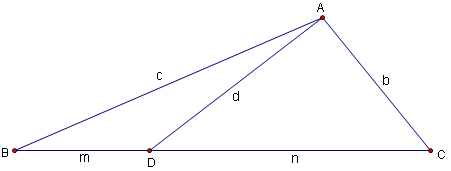Stewart's Theorem
Statement

If a cevian of length d is drawn and divides side a into segments m and n, then
Proof
For this proof, we will use the law of cosines and the identity ![]() .
.
Label the triangle ![]() with a cevian extending from
with a cevian extending from ![]() onto
onto ![]() , label that point
, label that point ![]() . Let CA = n. Let DB = m. Let AD = d. We can write two equations:
. Let CA = n. Let DB = m. Let AD = d. We can write two equations:
When we write everything in terms of cos(CDA) we have:
Now we set the two equal and arrive at Stewart's theorem: ![]() .
.









